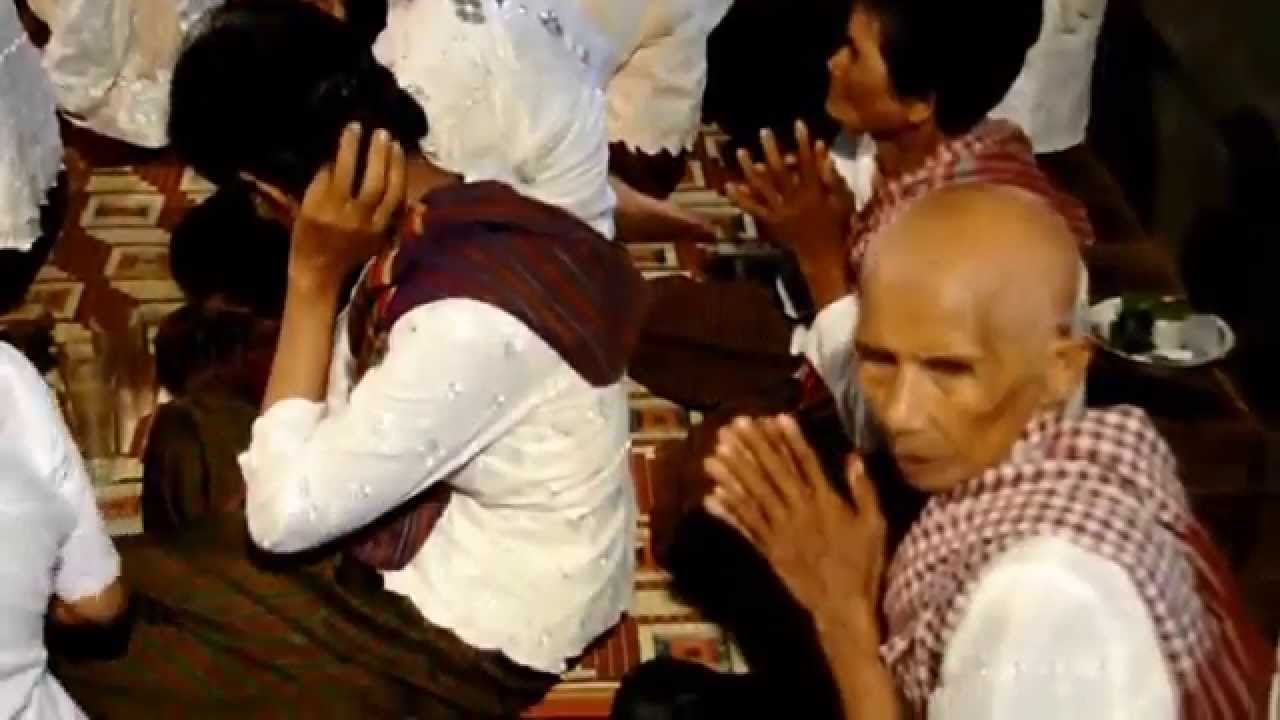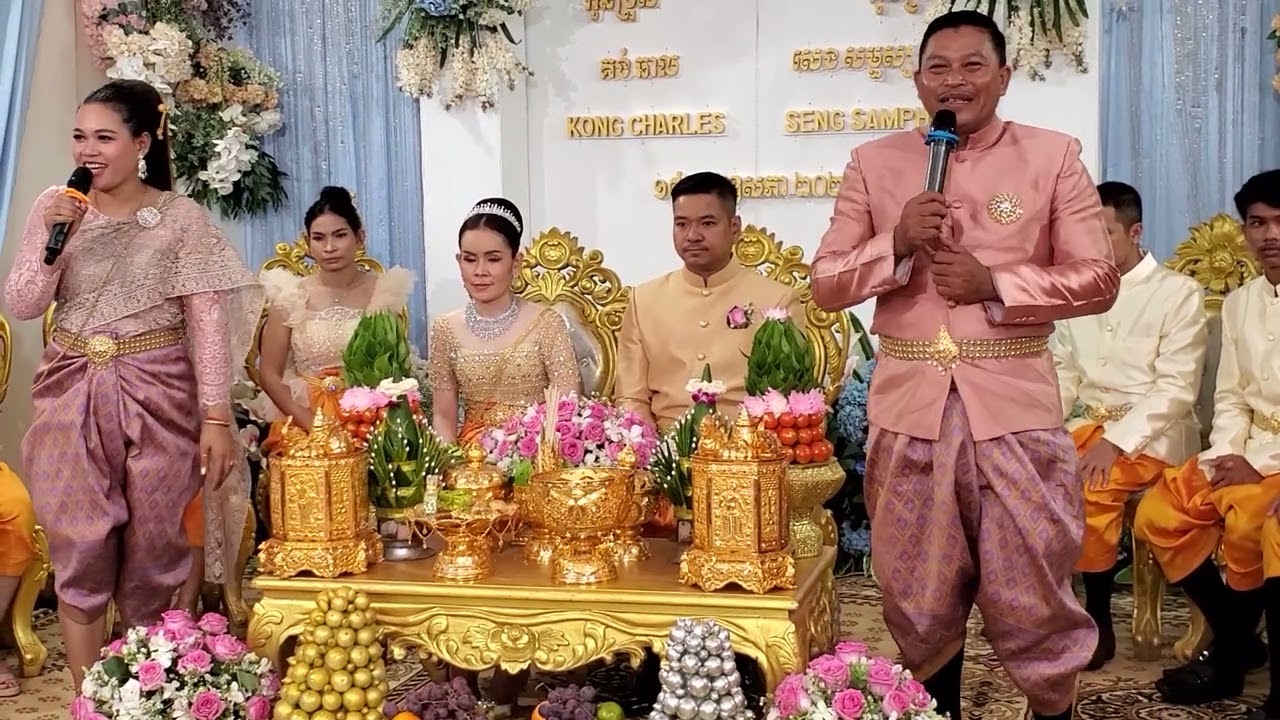Cambodia, located in the heart of Southeast Asia, boasts a rich tapestry of history, culture, and spirituality. With a population exceeding 15 million, predominantly Buddhists, the country stands as a testament to how traditions evolve under the influence of geography, history, and societal norms.
Cambodian weddings are elaborate affairs that can last up to multiple days. Every day, various ceremonies take place, such as the soat mun (monk blessing), sien doan taa (honoring the ancestors), and sompeas ptem (knot-tying ceremony). Each of these ceremonies reflects a unique aspect of the Cambodian wedding tradition.
Let’s delve into the elaborate Cambodian wedding customs and explore each day’s significance and associated ceremonies.
Cambodian Wedding Traditions
Day One of a Traditional Cambodian Wedding
1. Dowry Ceremony
Similar to many global cultures, including that of Egypt and Guyana, Cambodian traditions incorporate the giving of a dowry. Presented to the bride’s parents, this could be in the form of cash or valuable gifts, reflecting the groom’s capability to provide and his family’s status.
2. Soat Mun (Monk Blessing)
With around 90% of the country’s population practicing Buddhism, it dominates the religious composition of Cambodia. As a result, monks play a significant role in Cambodian wedding traditions.
While everyone bows their head, clasps their hands together, and keeps quiet, the monk will sprinkle flowered water on the couple and guests as they chant their blessings.
3. Bang Chhat Madaiy (Honoring the Parents)
Afterward, the bride and groom will offer sugar and fruit to their parents. While this is happening, the emcee of the ceremony makes a speech regarding the couple’s responsibility to respect and honor their parents.
Day Two of a Traditional Cambodian Wedding
4. Hai Goan Gomloh (Groom’s Processional Parade)
Similar to the beginning of the first day, Hai Goan Gomloh starts with the groom and his family going to the bride’s house. Guests who chose to come traditionally bring a silver tray of fruits and gifts. Upon arrival, the trays are placed on the ground or on a table. A young girl then dances and sings between the trays, chanting about the groom’s wealth.
At this point, the couple will also exchange rings. Concurrently, friends and relatives will be introduced.
5. Sien Doan Taa (Honoring the Ancestors)
Many Cambodian households have an altar for their ancestors. In this part of the ceremony, the couple will face the altar, bow their heads, and then offer tea and food. A family representative ‘calls’ for the ancestors and ‘introduces’ the couple, invoking that they ‘accept’ and ‘watch over’ the new member of their family.
6. Gaat Sah (Hair-cutting Ceremony)
Cambodian wedding traditions state that cutting a few strands from the bride’s and groom’s hair marks a fresh start, preparing them for married life.
The first cut, which symbolizes abundance, longevity, and joy, is performed by the officiant. Afterward, the couple’s parents and relatives will take turns in cutting their hair as well. This act signifies their well-wishes and blessings.
Day Three of a Traditional Cambodian Wedding
7. Bongvul Pbopul (Passing of Blessings)
Family, friends, and guests alike participate in this ceremony. Every married couple in attendance will form a circle, with enough space in the middle for the couple to kneel on. Three lit candles will be given and passed clockwise.
The recipient of the candle moves their hand above the flame to let the smoke reach the couple. This smoke is believed to shield the couple from evil. Moreover, it also represents a passing down of wisdom, fortune, and happiness from the older couples to the newlyweds.
8. Sompeas Ptem (Knot-Tying Ceremony)
Whereas Middle Eastern cultures such as the Lebanese use a ceremonial sword to cut their wedding cake, Cambodian men wield a gold sword before the knot-tying ceremony begins. This Cambodian wedding custom symbolizes the groom’s responsibility to keep his bride safe.
The couple will kneel down while holding the sheathed sword. Family members and guests will then tie a red string around the bride and groom’s wrists. This knot is symbolic of the protection and safety that family members and guests wish upon the couple. Generally, this ceremony is the guests’ opportunity to send their well wishes and blessings to the couple.
The ceremony ends with the guests throwing “pka sla” or white seeds taken from palm tree pods to the couple. These seeds are a symbol of blessings and goodwill. Afterward, the couple walks in a clockwise direction while the groom holds his sword with his left hand and part of the bride’s dress with his right hand.
Other Cambodian Wedding Customs
9. Arranged Marriages are Common
Cambodia has a family-oriented culture. This means that families typically vet the person their child is marrying. Parents sometimes refuse proposals if they find that the spouse is not fit for their child. For instance, if a groom is unable to pay the dowry set by the bride’s parents, they might not give their blessing for the marriage.
The use of a matchmaker is also common. It is customary for a Khmer man to seek the assistance of a matchmaker, usually an older person, who would visit the mother of a woman to gather information.
Their compatibility is then determined; if the matchmaker finds that the man and woman are compatible, the man’s family will send a mediator to formally propose. The mediator may go on multiple visits, bringing gifts for the woman’s family each time.
Additionally, it is not uncommon for blood relatives to get married.
These practices are much more prevalent in rural areas. Due to the influence of Western culture, Cambodians in urban regions are more likely to marry someone of their own volition.
10. Ages of the Couple
On average, Cambodian women get married at the age of 16 to 22. For men, the average age is 19 to 25. Similar patterns can be observed in Ecuadorian weddings. Whereas men seldom marry older women, it is common for women to marry older men — usually, the groom is around 12 years older than his bride.
11. The “Three Jewels” of Buddhism
As illustrated above, traditional Cambodian weddings consist of multiple ceremonies that take place over the course of three days. Furthermore, the number three holds religious meaning for Cambodians; the “three jewels” of Buddhism, namely Buddha, the Sangha, and the Dhamma. These three pillars provide comfort and protection for Buddhists.
12. Weddings Occur on Specific Months
Cambodians place a lot of emphasis on the importance of choosing the right time for the wedding. They believe that certain days are luckier than others; thus, holding the ceremonies on those days will bless the couple with a harmonious and bountiful marriage.
Khmer tradition is particular on which months couples are allowed to get married: January, March, May, July, and October. Only seven days in each month are considered fit for a wedding; additionally, weddings should not coincide with couples’ birthdays, a religious day, an eclipse, or during the Khmer new year.
For practical reasons, Cambodians do not hold weddings during the rainy season. Ceremonies and receptions will be challenging, if not impossible, to conduct. Additionally, guests might not be able to travel due to the weather. Farmers also tend to be busiest during this time as well.
13. Multiple Outfit Changes
Each ceremony across the three-day traditional wedding is treated as a standalone event. As such, it is customary for the groom, bride, and bridal party to change their outfits, accessories, and hairstyles in between ceremonies.
As a result, couples will be seen with around seven different outfits; these outfits must vary in their appearance. Colors and patterns are mixed and matched. Five to seven people are typically necessary to assist the bride as she changes into a traditional Cambodian wedding dress
14. Everyone is Invited
15. Gifts are Expected
Alongside an invitation, guests are also handed an envelope which they are expected to put cash. This gift of cash signifies a blessing for the couple and their married life. It may also be used to cover some of the costs of the wedding.
To reiterate, everyone is invited to Cambodian weddings. Corollary to this, even if the guest is a stranger, they are anticipated to give at least $20 as a gift. In contrast, if the guest is a relative or a close friend, they have to give more than $20.
Someone, usually the mother-in-law, sits by the reception table with a book. She will observe each guest, jotting down their names and how much they gave. This is done so that couples know how much money they will gift at their guests’ weddings in the future.
16. Attire for Guests is Semi-Formal and Conservative
Unless a specific type of attire is required, the safe option for guests is to dress semi-formal, adhering to the Cambodian wedding guest attire standards. Men can wear long-sleeved dress shirts and button-downs, while women can wear skirts or dresses. Additionally, women can also wear a traditional Cambodian dress, but it is not compulsory.
However, women should refrain from showing their shoulders, especially if the wedding is taking place in a province.
17. Parties in Between and After the Ceremonies
As stated above, each ceremony within a Cambodian wedding is considered an individual event. This means that in between ceremonies, guests are free to roam around and do their own thing while waiting for the next one to begin. At this time, plenty of food is placed outside the family’s home or in the ceremony area. Guests can help themselves to as large and as many servings as they would like.
After all of the ceremonies, the families may choose to hold a reception. If they do, they will usually serve a 10-course, traditional Cambodian-style banquet. Dishes often consist of seafood, meat, fish, vegetables, fruits, and sweets. Alcoholic drinks like beer are also served. While all of this is taking place, upbeat music is playing in the background as everyone sings and dances along.
18. Newlyweds Live with the Wife’s Parents
The practice of bride service is much more common in rural areas. Bride service refers to the vow a groom makes to serve his father-in-law for a certain amount of time. This entails that the newlyweds live with the wife’s parents to fulfill this vow.
Final Thoughts
A country’s history, geography, culture, and community shape and influence its wedding traditions. In Cambodia, these culminated in a multi-day celebration with various ceremonies that all emphasize the importance of families and ancestors. For Cambodians, the rituals and traditions observed represent the very essence of wedding traditions in Cambodia. Marriage, in this context, is a sacred ritual integral to their society.

